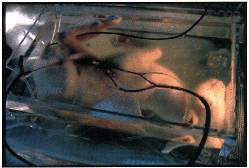|
Baby
in a Box
Half
a world away, in the laboratory of Yosinori Kuwabara and his colleagues
at Juntendou University in Tokyo, a fetal goat floats in a clear
acrylic tank the size of a large toaster oven, bathed in eight quarts
of artificial amniotic fluid kept at body temperature. Its umbilical
cord is threaded to two machines that jointly perform the nuts and
bolts of a placenta, pumping in blood, oxygen and nutrients and cleaning
out waste. The fetus is almost 20 weeks old, weighs about six pounds
and has been living in its eerie fishbowl of a universe since it
was removed from its mother by caesarean section several days earlier.
The creature behaves like any other prenatal goat, blinking its
soft black eyes and kicking its slender white limbs. Should it survive
to the full 21-week goat term, it will be "born": lifted out of
the tank and its umbilicus cut.
of a placenta, pumping in blood, oxygen and nutrients and cleaning
out waste. The fetus is almost 20 weeks old, weighs about six pounds
and has been living in its eerie fishbowl of a universe since it
was removed from its mother by caesarean section several days earlier.
The creature behaves like any other prenatal goat, blinking its
soft black eyes and kicking its slender white limbs. Should it survive
to the full 21-week goat term, it will be "born": lifted out of
the tank and its umbilicus cut.
Dr. Kuwabara
and his co-workers are striving to create a viable artificial womb,
a system to sustain a developing infant when the real womb won't
or can't do it. So far, the researchers have managed to keep their
goats-on-a-rope alive for up to 10 days, and they are getting closer
to understanding why the artificial environment eventually fails
its charges.
The scientists
hesitate when asked when their experimental uterus will be ready
for human use, but others happily speculate for them. "There are
a lot of difficult technical problems to be overcome," says Malcolm
Levene, professor of pediatrics and child health at the University
of Leeds in England. "But I see them as being soluble in the next
5 to 10 years."
|

